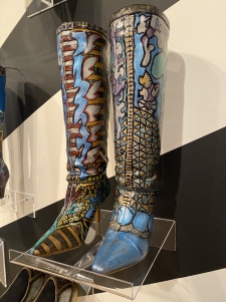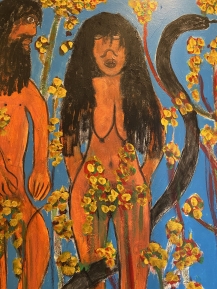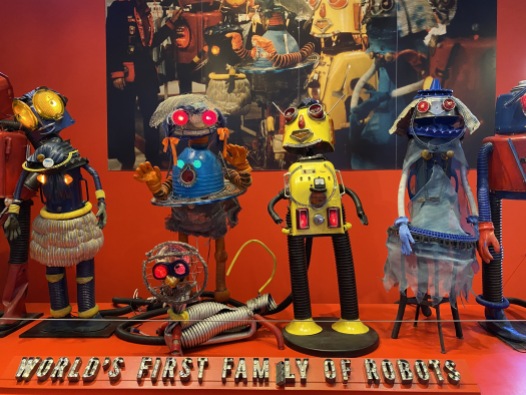On Saturday morning, I made coffee in my hotel room and ate a very sticky and decadent iced cinnamon roll. It was yummy but probably 1,000 calories!
It was a long slow walk to the American Visionary Art Museum in Federal Hill. It would have been a lot more enjoyable if I hadn’t hurt or twisted (or broken?) my left ankle the day before. It was a lovely sunny day.

American Visionary Art Museum

American Visionary Art Museum
Visionary Art, as defined by the museum, “refers to art produced by self-taught individuals, usually without formal training, whose works arise from an innate personal vision that revels foremost in the creative act itself.” It has to do with listening to the voices of the soul.
Fred Carter’s (1911-1992) paintings and woodcarvings reflected his take on encroaching environmental destruction, social injustices, and everything he loved and felt deeply about.
Mary Proctor, born in 1960, paints doors, covering them with spiritual images and messages with a jumble of buttons, fabric, mirrors, and other found objects.
Wayne Kusy, born in 1961, completed The Lusitania in 1994; it is 16 feet long and took 194,000 toothpicks and 2 1/2 years to complete. He specializes in 20th century ocean liners because he admires “the detail and prestige [they] had.”
I enjoyed Rick Skogsberg’s Can’t Lose Shoe Collection, a mix of painted new and found shoes and boots from 2014-2016.
I enjoyed the museum’s quirky and thoughtful exhibits. The main one was “The Secret Life of Earth: Alive! Awake! (And Possibly Really Angry!)” timed to coincide with the 50th anniversary of Earth Day. The exhibition included little known facts about nature, information on how our diets and other individual behaviors influence our environment, the difference between weather and climate, the health and environmental price of using pesticides, the effects of a capitalist economy on the environment, positive solutions to many environmental problems, and even humor.

The Secret Life of Earth: Alive! Awake! (And Possibly Really Angry!)”
At the Earth exhibit was a televised interview with Greta Thunberg by Trevor Noah. She commented about the U.S. conversation around climate change as if we “believe it or not,” whereas, where she’s from, it’s a fact. Smart girl!
There was an interesting exhibit of “Reverend Albert Lee Wagner: Miracle at Midnight.” It had been ongoing since July 1, 2017 and would leave the museum on June 5, 2020.
Born into great poverty in rural Arkansas to a family of cotton pickers, Wagner was first-hand witness to extreme prejudice and racial violence. Not until the family later moved north to Ohio did Wagner feel the freedom to speak out on the horrors he had witnessed and began making “story pictures,” accompanied by his hand-written testimony.
Especially saddened by the increase of black on black crime, Wagner evolved into a lover of all humankind, greatly concerned with our human condition.
There was an especially amazing huge painting: Flee from Egypt – Moses Parting the Red Sea.

Flee From Egypt (Parting of the Red Sea), 1975 by Reverend Albert Wagner
The title of the exhibit is from a transformative moment when house paint spilled on a floor board, forever changing an actively sinning Wagner as he prepared for his 50th birthday. Transfixed by the scene of pooling paint, he experienced a spiritual awakening (epiphany), forever ending his womanizing and kick-starting an intense period of religious service and art-making that would endure until his peaceful death at the age of 82.
Maya Angelou’s wise observation: “If one is lucky, a solitary fantasy can totally transform a million realities.”
Another fascinating exhibit was “Esther and the Dream of One Loving Human Family.” This features Esther Krinitz’s Holocaust survival story told through 36 hand-embroidered works. It pays tribute to humanity’s long history, past and current, of unjustly persecuted innocents and the dream of a world at peace.
Also, there was work gathered from a partnership with Rwandan Tutsi genocide survivors and more. In this work, humanitarian and art activist Lily Yeh depicts Rwandan village life before, during, and after the 100 days of the Rwandan 1994 Genocide that left over 800,000 Tutsi men, women, elders and children murdered, mostly by brutal machete attack.

Lily Yeh’s Work with the Rugero Survivors Village, Rwanda

Lily Yeh’s Work with the Rugero Survivors Village, Rwanda

Lily Yeh’s Work with the Rugero Survivors Village, Rwanda
Prayer for Peace, by Apache Elder Judy Tallwing, is a painting infused with thousands of tiny glass prayer beads — each one a sincere focal point that Judy has used to pray for someone’s blessing or healing, other than for herself. Judy’s painting features two stylized stealth bomber military planes. Her message speaks to the essence of the Truth & Reconciliation mission. She explains, “The only way we will ever obtain peace in our own families, our communities,, and throughout the world, is if we rise above all the stealth or secret ways in which we act, and have acted, to secretly harm one another.”

Prayer for Peace, by Apache Elder Judy Tallwing
There was other quirky art found in the museum.
David R. Klein’s Pez collection began at the time of a surprise 40th birthday party when someone gave him a variety of gag gifts, among which was a Pez dispenser. Shortly after that, he came across a vendor selling a variety of Pez dispensers at a Pennsylvania flea market, and he began to collect them.
I wandered over to an adjacent building and found these treasures between the two buildings.
Inside the Jim Rouse Visionary Center, I found painted screens, Fifi and friends from the Kinetic Sculpture Race, Leonard Knight’s Love Balloon, Andrew Logan’s Divine, and Devon Smith’s World’s First Robot Family.
The young lady in the gift shop suggested I walk ten minutes to the Cross Street Market in Federal Hill, where I could find a lot of eateries. Taking her advice, off I went, dragging my poor hurt ankle along!
*Saturday, February 22, 2020*








































































You must be logged in to post a comment.